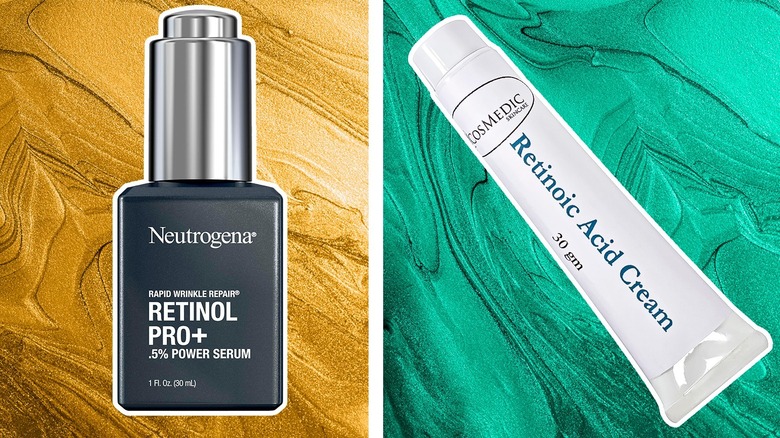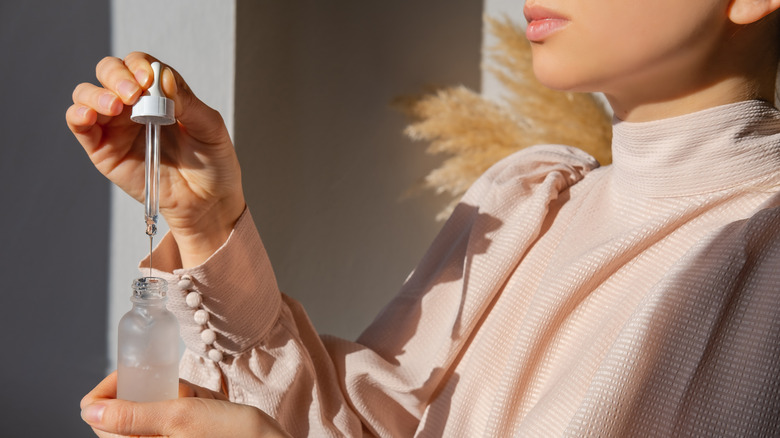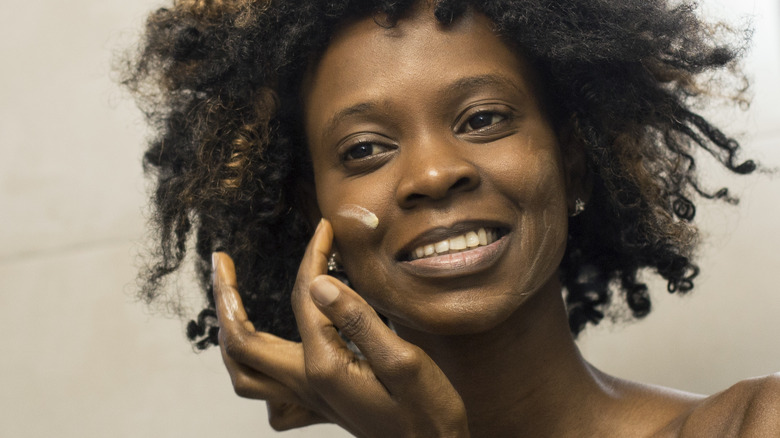Retinol Vs Retinoic Acid: What's The Difference?
We may receive a commission on purchases made from links.
These days, it seems like almost everyone incorporates retinoids and retinol into their skincare routines. It's easy to see why – retinoids can promote clearer, softer skin, improve cell turnover, and reduce the appearance of pores and fine lines (via Healthline). However, the difference between retinol and retinoids may not be fully understood, even if you diligently apply a pea-sized dab of tretinoin nightly. Adding terms like retinoic acid only makes things more confusing.
First, it's important to acknowledge the difference between retinoids and retinol. "The term 'retinoid' is an umbrella term used for both synthetic and natural derivatives of retinol," dermatologist Dr. Kellie Reed told Forbes. All retinol products are considered retinoids, but over-the-counter products that contain retinol work differently than prescription-strength retinoids like Retin-A. In contrast, retinoic acid is the active form of retinoid that the body can use immediately. So, how does this cause retinoic acid to differ from retinol?
The relationship between retinol and retinoic acid
Okay, we know that all retinol is retinoid, but what's the deal with retinoic acid? As already mentioned, retinoic acid is the active variety of retinoids. In fact, another name for tretinoin is retinoic acid. Retinoic acid is easily absorbed and utilized by your skin, which is why ailments like skin purging and flakiness can be so pronounced when using prescription-strength retinoids. They're essentially pure, bioavailable retinoic acid, and you only need a small amount of product to see results rather quickly. In fact, according to research published in the International Journal of Women's Dermatology, study participants who used tretinoin reported reduced signs of wrinkling and hyperpigmentation in as little as one month.
Over-the-counter retinol, like a drugstore night cream, contains small amounts of retinoic acid but operates a little differently. "The enzymes in our skin have to convert retinol twice (first to retinal, then retinoic acid) before it can be digested by the body (and skin)," dermatologist Dr. Geeta Yadav explained to Real Simple. Thus, it may take a while for first-time retinol users to see results compared to those using prescription-strength retinoids. However, taking it slow and steady isn't necessarily bad, especially if you have sensitive or reactive skin. By using products with retinol, you can ease sensitive skin into retinization, the process of acclimating your complexion to retinol or retinoids.
Should you use retinol or retinoids?
Naturally, you may be wondering whether to use retinol or retinoids in your skincare routine. If you've never used retinoids, you might be better off starting with retinol to see how your skin responds. "If you have sensitive or dry skin, I recommend starting with over-the-counter retinol or retinal. The more potent, the more potential for redness, irritation, and dryness," dermatologist Dr. Charlotte Birnbaum told Glamour. Furthermore, avoiding mixing other actives with retinol, such as benzoyl peroxide or chemical exfoliants, is crucial to prevent irritation. Try starting with a gentle retinol product with built-in moisturizers, such as Kiehl's Micro-Dose Anti-Aging Retinol Serum, if you have sensitive skin.
If you're a seasoned retinol user, you may want to consider incorporating prescription retinoids with the more active retinoic acid. You'll need to consult with a dermatologist or physician to obtain a prescription for a topical retinoid, though you can also use online telemedicine services such as Nurx.com. Prescription retinoids are available in varying strengths and go by names such as tretinoin, Retin-A, or Atralin. Your doctor can advise you on which formula is best for you. It's also worth noting that even if you have thicker skin, you shouldn't mix multiple types of retinoids or use too many actives at once while getting acclimated to retinoids. A damaged skin barrier from retinol overuse or misuse can result in redness, sensitivity, and irritation. Fortunately, you can reverse these aggravations by scaling back on your retinoid routine and using gentler skincare.


